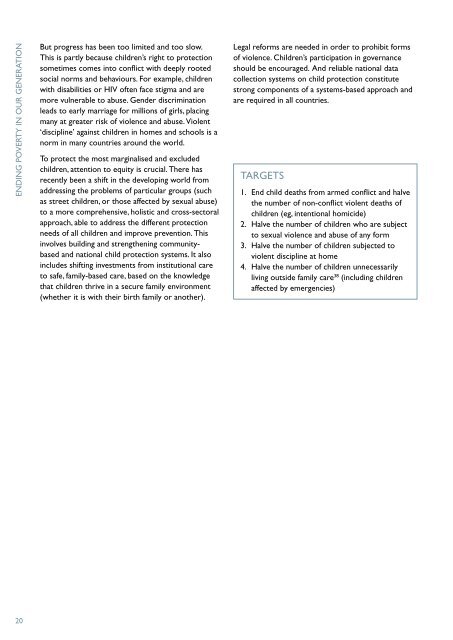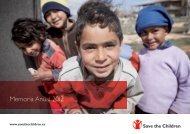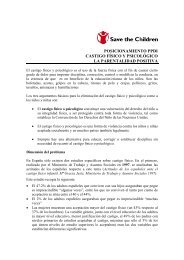ENDING poverty - Save the Children
ENDING poverty - Save the Children
ENDING poverty - Save the Children
You also want an ePaper? Increase the reach of your titles
YUMPU automatically turns print PDFs into web optimized ePapers that Google loves.
<strong>ENDING</strong> POVERTY IN OUR GENERATION<br />
But progress has been too limited and too slow.<br />
This is partly because children’s right to protection<br />
sometimes comes into conflict with deeply rooted<br />
social norms and behaviours. For example, children<br />
with disabilities or HIV often face stigma and are<br />
more vulnerable to abuse. Gender discrimination<br />
leads to early marriage for millions of girls, placing<br />
many at greater risk of violence and abuse. Violent<br />
‘discipline’ against children in homes and schools is a<br />
norm in many countries around <strong>the</strong> world.<br />
To protect <strong>the</strong> most marginalised and excluded<br />
children, attention to equity is crucial. There has<br />
recently been a shift in <strong>the</strong> developing world from<br />
addressing <strong>the</strong> problems of particular groups (such<br />
as street children, or those affected by sexual abuse)<br />
to a more comprehensive, holistic and cross-sectoral<br />
approach, able to address <strong>the</strong> different protection<br />
needs of all children and improve prevention. This<br />
involves building and streng<strong>the</strong>ning communitybased<br />
and national child protection systems. It also<br />
includes shifting investments from institutional care<br />
to safe, family-based care, based on <strong>the</strong> knowledge<br />
that children thrive in a secure family environment<br />
(whe<strong>the</strong>r it is with <strong>the</strong>ir birth family or ano<strong>the</strong>r).<br />
Legal reforms are needed in order to prohibit forms<br />
of violence. <strong>Children</strong>’s participation in governance<br />
should be encouraged. And reliable national data<br />
collection systems on child protection constitute<br />
strong components of a systems-based approach and<br />
are required in all countries.<br />
TARGETS<br />
1. End child deaths from armed conflict and halve<br />
<strong>the</strong> number of non-conflict violent deaths of<br />
children (eg, intentional homicide)<br />
2. Halve <strong>the</strong> number of children who are subject<br />
to sexual violence and abuse of any form<br />
3. Halve <strong>the</strong> number of children subjected to<br />
violent discipline at home<br />
4. Halve <strong>the</strong> number of children unnecessarily<br />
living outside family care 38 (including children<br />
affected by emergencies)<br />
20
















